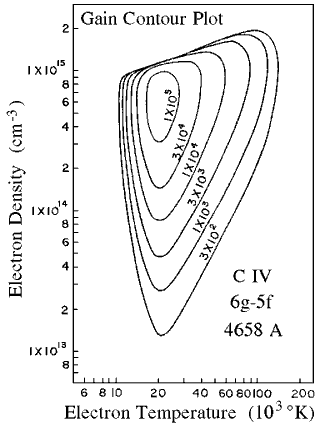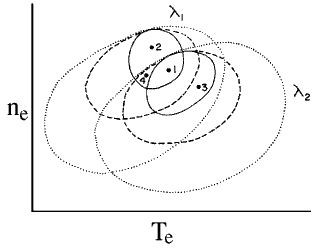THE STRENGTH OF THE EMISSION LINES IS DUE TO LASER ACTION
Gudzenko and Shelepin
proposed that if the free electrons in plasma cool sufficiently rapidly, there
can be a population inversion in the lower levels of the atom, and this can
lead to laser action. Gudzenko, Filipov and Shelepin
showed that such a rapid cooling can be achieved by expanding a plasma jet into
a vacuum. The basic theory for obtaining the properties of a decaying plasma
was given by Bates, Kingston and McWhirter
and is called the collisional radiative model. A number of workers, using this
model, have carried out calculations on the properties of a rapidly decaying
monatomic plasma. The results obtained from a number of subsequent experiments
for the recombination rates are for the most part in reasonable agreement with
those calculated from the collisional model. Detailed theoretical calculations
(Zemtsov and Yu, Bohn )
of the population densities of excited levels in a decaying hydrogen
(and hydrogen-like ions) plasma flow predicted population inversions at
electron densities (ne=10^13 to 10^16 cm^-3) and electron temperatures
(Te=5000 to 10^5 deg. K) with magnitudes which are very close to those
existing in stellar atmospheres. The prediction regarding the inversion
in the atomic level populations has been amply confirmed in several laboratory
experiments (Hoffmann, et al.).
The subject has been reviewed by
Gudzenko et al.
Also, it is well known that in certain types of stars
(Wolf-Rayet,
P Cygni),
matter is ejected more or less continuously.
We have thus proposed the following realistic model of a quasar : A quasar
is a star in which the surface plasma is undergoing rapid radial expansion
giving rise to population inversion and laser action in some of the atomic
species. The assumption of the ejection of matter from quasars at high speed
is supported from the fact that the widths of emission spectral lines observed
in quasars are typically of the order of 2000 - 4000 km/sec. We call the
proposed model the plasma-laser star (PLS) model. Let us then examine the
consequences of this model.
Detailed calculations on the properties of a rapidly decaying monatomic plasma
have been carried out by a number of workers (Zemtsov and Yu, Bohn, Drawin).
The population
densities of the excited levels are functions of the electron density (ne),
the electron temperature (Te), and the density of ground state atoms (n(1)).
In stellar atmospheres , n(1) is a function of ne and Te. thus the state of
plasma, after expansion, in a star can be represented by a point on a plot
with ne and Te as axes.

Laser gain versus electron density and electron temperature.
For a given transition in a given atom, strong population
inversion takes place only within a narrow area in the ne, Te diagram.
This area is surrounded by a medium population inversion area,
which in turn is surrounded by a weak population inversion area. On the high
ne side, the boundary of the population inversion is rather steep.
(Strong population inversion regions will give rise to strong lines, and
similar statements hold for the medium and weak inversion regions.)

Contour diagram representing the laser gain regions of two wavelenghts,
L1 and L2, arising from different transitions in different atoms.
Solid line represents region of strong population inversion, dashed equals medium
and dotted is weak.
We consider what will be observed if the emission-line
region of a quasar corresponds to the different points shown on the diagram.
- Point 1: L1 strong, L2 strong.
- Point 2: L1 strong, L2 absent.
- Point 3: L1 weak, L2 strong.
- Point 4: L1 strong, L2 medium,
- and so on...
Thus a whole range of relative intensities is possible. We next consider the
observational evidence relevant to this point. We have carried out spectral
classification of quasars. There are quasars which show two or more emission
lines at practically the same wavelength; such quasars were put together in
a group. In the redshift interpretation, quasars belonging to the same group
tend to have the same redshift. We give here three examples in which wide
variations in relative intensities have been recorded; we have restricted
ourselves to only such cases where the two quasars were investigated by the
same astronomer(s) using the same telescope.
- 3C 309.1 and 0957+00. Spectra of both quasars were obtained by Lynds and
his coworkers (1966, 1967, 1968)
on the Kitt Peak 84-inch telescope, and are reproduced
in Fig.3. Both quasars show two emission lines at 3640 (±5) Å and 5337
(±5) Å respectively. 3640 Å is stronger than 5337 Å in 0957+00,
but 3640 Å, is quite weak in 3C 309.1, in which 5337 Å is very strong.
- 3C 208 and 3C 204. Spectra of both quasars have been obtained by Schmidt
on the Palomar telescope. 4030 Å is of medium strength in both the quasars,
but 3275 Å is medium in 3C 208, and weak in 3C 204.
- 1508-05 and 2329-384. Spectrograms for both the quasars were obtained by
Peterson and Bolton on the Mount Stromlo 74-inch telescope. 4185 Å is
strong in both the quasars. On the other hand, another line, 3396 Å is
strong in 2329-384, but weak in 1508-05.
It is obvious that these results are in strong support of the PLS model
regarding the relative intensities of emission lines.
Varshni and Lam
have presented model calculations for laser action in He II 4686 Å within
the framework of the PLS model. More recently
Varshni and Millette
have performed computations on laser action in C IV, N V and O VI,
Varshni and Nasser
have performed the same computations on the levels of He I and C III. There is
also an online thesis;
Talbot (1994)
based on the work by Millette on laser action in C IV.
Back to Main Paper


